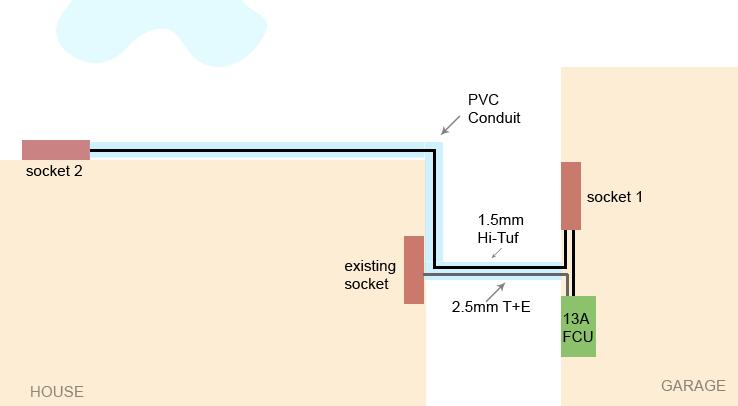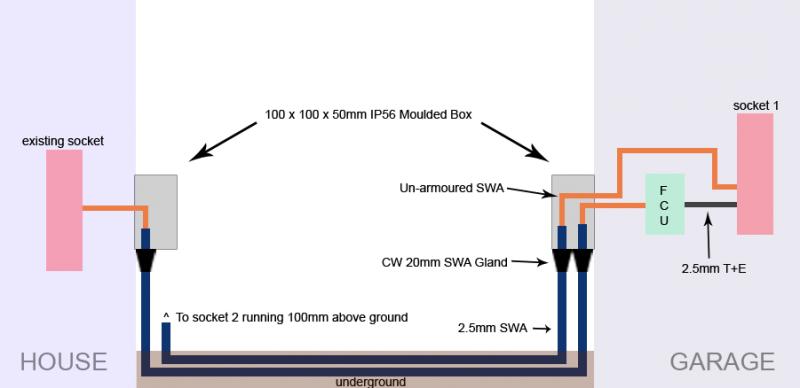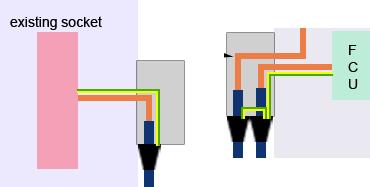You are using an out of date browser. It may not display this or other websites correctly.
You should upgrade or use an alternative browser.
You should upgrade or use an alternative browser.
Outdoor socket advice
- Thread starter morg
- Start date
only just.. it's level with newcastle...
I thought he ment ross-on-wye
I thought he ment ross-on-wye
You missed two:So what would be the difference between a qualified person and a keen diy'er to fit an outdoor socket here be?
Ok a botch job by a diy'er might include
Adding an outdoor socket to a unsuitable existing socket
Loose connection when adding the extra cable to the existing socket or insulator rammed into the terminal connectors,
cable overstripped/understripped, bending the cable and maneuvering it in awkward ways which might weaken it
Inappropriate parts used or not used (cable size, enclosure boxes, sockets, cable glands etc)
Choc blocks wrapped in insulation tape
Burying normal cable in the lawn
Fitting the socket next to the outside tap
- Putting 2 sockets on a spur which you were all set to do, and would have done if you hadn't mentioned it in passing, because that wasn't something you thought you needed to ask about.
- Not doing any testing.
Hi thanks for the advice mate.
Yes, directly from existing socket.
I will also take your advice then, so I'll get a FCU, what cable should I run from the existing socket to a FCU then?
You can use 2.5mmsq T+E for your short spur from the nearby indoor socket to the FCU supply terminals, also indoors. From the FCU load side terminals you can use your 1.5mmsq HiTuf.
I might even think about putting the FCU in the garage, and running another cable out from garage to pond equipment.
I'm not sure that would work. The FCU is there as you're only allowed one unfused spur from any point on a ring final circuit, be it a double socket, FCU, single socket, or any other electrical accessory. If you spur from the indoor socket to the outdoor, and also to an FCU in the garage feeding another outdoor socket, that's more than one accessory being fed by an unfused spur.
Why not go indoor socket > 2.5mm T+E > FCU supply > FCU load > 1.5mm HiTuf > garage socket > 1.5mm HiTuf > Pond socket, thus alleviating the need for a JB?
No I wasn't planning on burying this stuff, it's going to run about 100mm above ground, is this ok? Or should I use conduit anyways?
Nah, that should be fine, it'll take a fair bit of hammer to damage HiTuf. It's fun enough to strip with a sharp knife, never mind garden tools.
Many thanks again for the help electronicsuk, cheers
Why not go indoor socket > 2.5mm T+E > FCU supply > FCU load > 1.5mm HiTuf > garage socket > 1.5mm HiTuf > Pond socket, thus alleviating the need for a JB?
Is the pic below is how you recommend?
by the way, I'll need to use conduit because the 2.5mm T+E needs to go underground (down, under, up, in), so may as well use conduit to pond socket,
sorry mistake in pic, from FCU to socket 1, I'll also use 2.5mm T+E
T&E is not suitable for use underground, whether in conduit or not.by the way, I'll need to use conduit because the 2.5mm T+E needs to go underground (
If 'existing socket' is the existing indoor socket on the ring final, the layout presented in your drawing appears to be correct. However, it would make more sense for the FCU to be located in the same place as the existing socket, thus limiting the length of the unfused spur.
As already mentioned, you can't use T+E underground, nor HiTuf. You would either need to use SWA or earthed metal conduit, but I couldn't really recommend either of these to someone who's never used them before, as they take time and practice to terminate correctly.
Hi mate, thanks again for all the help,
I know what your saying about limiting the length, it will be about 2 metres before it reaches the FCU in the garage, is this way too much?
If you say yes, then the only other option I have is just use this existing socket to supply just one socket in the garage or fit the FCU indoors.
There are also 2 single sockets on the back wall, both on spurs, I know these aren't suitable to add a socket directly too, but can you add a FCU to one of these and trail a socket outside? I guess the answer is no, but it's worth a shot!
Thanks again for the help, you've been really helpfull
I know what your saying about limiting the length, it will be about 2 metres before it reaches the FCU in the garage, is this way too much?
If you say yes, then the only other option I have is just use this existing socket to supply just one socket in the garage or fit the FCU indoors.
There are also 2 single sockets on the back wall, both on spurs, I know these aren't suitable to add a socket directly too, but can you add a FCU to one of these and trail a socket outside? I guess the answer is no, but it's worth a shot!
Thanks again for the help, you've been really helpfull
There is no problem with the short unfused spur, it just makes more sense to avoid it given the chance.
Unfortunately you cannot feed your FCU from the two sockets you mention that are already unfused spurs from the ring, as an unfused spur is only permitted to feed one accessory.
Unfortunately you cannot feed your FCU from the two sockets you mention that are already unfused spurs from the ring, as an unfused spur is only permitted to feed one accessory.
Rhetorical question of course Rice.
Of course he doesnt even think about testing. Or Part P. As long as it works when he switches it on it must be OK.
Trouble with these sites - on the one hand at least people are asking for help and might take notice of advice given on the other hand it purely encourages more DIY bodges.
So what would be the difference between a qualified person and a keen diy'er to fit an outdoor socket here be?
Ok a botch job by a diy'er might include
Adding an outdoor socket to a unsuitable existing socket
Loose connection when adding the extra cable to the existing socket or insulator rammed into the terminal connectors,
cable overstripped/understripped, bending the cable and maneuvering it in awkward ways which might weaken it
Inappropriate parts used or not used (cable size, enclosure boxes, sockets, cable glands etc)
Choc blocks wrapped in insulation tape
Burying normal cable in the lawn
Fitting the socket next to the outside tap
A competent person should
a) make sure your earthing and bonding is adequate
b) make sure your cpc (earth wire) is connected - just because it is there does not mean it will be connected to anything
c) make sure your ring is in fact a ring.
d) test that the socket is wired correctly - polarity
e) check the insulation resistance of the cable
f) check your disconnection times
g) test the RCD with a RCD tester (not just the test button)
I will give you an real life example, a diy'er fitted some class 1 light fittings (a fitting that requires an earth connection) in a hall. He connected all the conductors including the cpc (earth wire). A few weeks later he went to change a lamp (light bulb) and got a shock. On initial inspection it was discovered that he has screwed into the cable that supplies the fitting making the metal fitting live. What was curious was that it looked like the cpc was connected - so why did the fuse not blow???
Further testing revealed that this part of the house was an extension and the lighting circuit had been extended to an existing light circuit without a cpc (a common practice in older homes), which is why the fuse did not blow.
A competent electrician who tests his work should have picked this up.
There is no problem with the short unfused spur, it just makes more sense to avoid it given the chance.
Unfortunately you cannot feed your FCU from the two sockets you mention that are already unfused spurs from the ring, as an unfused spur is only permitted to feed one accessory.
Thanks for the info! Thought it was a long shot
Am I ok to go ahead with the below drawing? Can you see any problems with it?
The drawing is illustrated as it will be ie the cw glands on the bottom of the boxes.
Also will be using another IP56 moulded box for socket 2 (with the swa cable and glands, unarmoured inside to connect to socket terminals).
All boxes gunned around back with silcone as Chri5 suggested.
Many thanks for the help
- Joined
- 28 Jan 2010
- Messages
- 641
- Reaction score
- 75
- Country

Erm, why not just mount the FCU inside the house next to the existing socket?
This would allow you to use 1.5mm SWA, and only need one run of it.
Yes, the glands MUST be earthed. Use an earth banjo or piranha nut inside the boxes and connect it to the CPC.
PS. Whilst there are many on here who do nothing but shout "get an electrician you incompetent mere-mortal!", kudos to you for wanting to do this properly, asking the questions and taking the advice on board.
This would allow you to use 1.5mm SWA, and only need one run of it.
Yes, the glands MUST be earthed. Use an earth banjo or piranha nut inside the boxes and connect it to the CPC.
PS. Whilst there are many on here who do nothing but shout "get an electrician you incompetent mere-mortal!", kudos to you for wanting to do this properly, asking the questions and taking the advice on board.
Hi mate, thanks for the advice 
Yes, it would make life easier, but I don't want a FCU in sight indoors, plus with the existing socket there is two beams running either side of socket, sort of sandwiched in I just think it will be too difficult and will be easier having it in the garage.
I just think it will be too difficult and will be easier having it in the garage.
Cheers for the earthing tip as well, piranha nuts i'll use then. Thanks for the kind comments too!! All the best
Yes, it would make life easier, but I don't want a FCU in sight indoors, plus with the existing socket there is two beams running either side of socket, sort of sandwiched in
Cheers for the earthing tip as well, piranha nuts i'll use then. Thanks for the kind comments too!! All the best
What's wrong with an FCU in sight? We're talking something like this...

Not something like this...

With it inside, make it a double pole FCU and you can easily isolate the external installation if, say, a fault occurs (eg water ingress) that trips the RCD on your socket circuit and doesn't let you reset it. Surely putting the FCU inside is less more difficult than all the extra external wiring with the FCU in the garage?

Not something like this...

With it inside, make it a double pole FCU and you can easily isolate the external installation if, say, a fault occurs (eg water ingress) that trips the RCD on your socket circuit and doesn't let you reset it. Surely putting the FCU inside is less more difficult than all the extra external wiring with the FCU in the garage?
DIYnot Local
Staff member
If you need to find a tradesperson to get your job done, please try our local search below, or if you are doing it yourself you can find suppliers local to you.
Select the supplier or trade you require, enter your location to begin your search.
Please select a service and enter a location to continue...
Are you a trade or supplier? You can create your listing free at DIYnot Local
Similar threads
- Replies
- 15
- Views
- 6K



